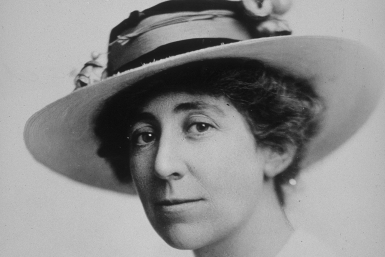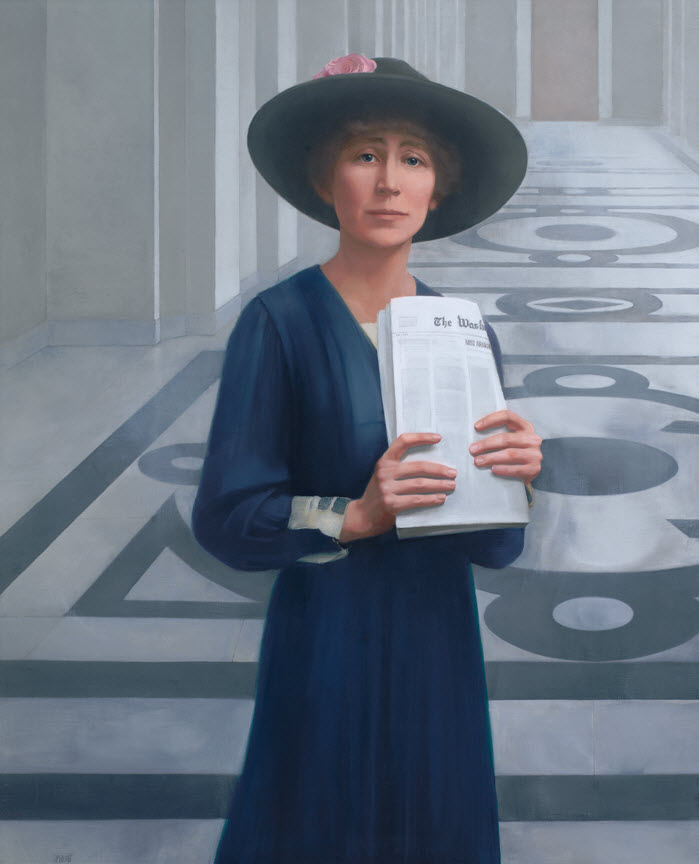The first woman in the United States to hold national office was Jeannette Pickering Rankin, who served in the U.S. House of Representatives from 1917-1919. Twenty-four years later, she served again in the House from 1941-43. Rankin was the only House members to vote against declaring war on Japan in 1941 and one of fifty who opposed entering the Great War in 1917. Having been elected before women could even vote, Rankin played a role in initiating the legislation that led to the 19th Amendment to the Constitution. For over six decades, she campaigned for gender equality and civil rights.
On June 11, 1880, Jeannette Pickering Rankin was born near Missoula, Montana, which was still a territory at the time, and would be until she was nine years old. Her father was a Scottish-Canadian immigrant rancher and carpenter named John Rankin, while her mother, Olive Pickering, was a schoolteacher. Jeannette was the oldest of six children with one brother and five sisters, however one died in childhood. Her brother Wellington later became Montana’s attorney general and an associate justice of the Montana Supreme Court.
During her teen years, Rankin would clean, sew, and help in taking care of her younger siblings. She also did her daily outdoor work and farm chores while helping to maintain the machinery at the ranch. Once, Rankin built a wooden sidewalk for one of her father’s buildings all by herself. Later on, she said that as a child she had observed that women worked side by side with men as equals in the 1890s western frontier, though they did not have an equal political voice and were denied legal voting rights.
In 1898, Rankin graduated from high school and went on to study Biology at the University of Montana, graduating in 1902 1ith a Bachelor of Science degree in biology. Because Rankin had no clear ambitions for what she wanted to do as a career, she started off as a dressmaker in Missoula before designing furniture in Boston while her brother studied at Harvard. Many marriage proposals were turned down as well.
To take up a social work job, Rankin moved to San Francisco at twenty-eight years old. There she had become confident she had found her calling and what she wanted to do as a career. So, Rankin enrolled in the New York School of Philanthropy (which is now part of Columbia University School of Social Work) and attended the school from 1908 to 1909. From there she moved to Spokane, Washington, serving as a social worker for a brief amount of time. Rankin attended the University of Washington which was where she became involved with the women’s suffrage movement. She spent some time working with the National American Suffrage Association (NAWSA) and helped organize the New York Women’s Suffrage Party. In november of 1910, an amendment to the state constitution in Washington was made that gave women legal voting rights. It was the fifth state in the Union to do this.
The first woman to speak before the Montana legislature was Jeannette Rankin in February of 1911, who was making her case for women’s suffrage. Montana passed an amendment in November of 1914 that gave women unrestricted legal voting rights. Later on she would compare her work towards women’s suffrage to that of the pacifist foreign policy that would define her career in Congress. In her eyes, the United States’ corruption was due to a lack of feminine participation.
In the congressional election of 1916, Rankin campaigned for one of the two at-large House seats in Montana. Her brother Wellington financed and managed her campaign as an influential member of Montana’s Republican Party. Throughout the campaign, she travelled long distances to reach the scattered population of the state. At train stations, street corners, remote one-room schoolhouses, and potluck dinners on raches, she rallied support. On November 7, 1916, with over 7,500 votes, Jeannette Rankin was elected to the United States House of Representatives as the first woman ever elected to Congress.
Congress was called into an April session shortly after her term began on March 4, 1917 in response to Germany’s recent declaration of unrestricted submarine warfare on any shipping through the Atlantic. President Woodrow Wilson addressed a joint session on April 2, 1917 and war was declared on Germany after an intense debate that lasted until 3 a.m. Rankin was one of fifty House members who voted against going to war. Despite the fact that she was not the only one to vote against it, she was singled out and widely criticized. Some people believed her vote was discrediting the suffragist movement but other people such as suffragist Alice Paul and Representative Fiorello LaGuardia of New York applauded her.
The Speculator Mine disaster in Butte left 168 miners dead on June 8, 1917. A huge protest strike was organized over working conditions. Rankin tried to intervene, but she was refused by mining companies and miners. Her proposed legislation was unsuccessful.
In forty states, women had been granted at least some form of voting rights by 1917. Rankin was the driving force for the unrestricted universal enfranchisement movement. She played a role in the Committee on Woman Suffrage and was one of its founding members. The committee delivered its report to Congress in January of 1918. Rankin opened up congressional debate on a proposed amendment to the constitution that granted women universal voting rights. While the resolution was passed through the House, the Senate defeated it. However, the following year in 1919, the resolution was passed through both chambers and ratified by three-fourths of the states. The Nineteenth Amendment to the United States Constitution was passed on August 18, 1920.
The Montana state legislature voted to replace the two at-large seats in the house to two separate districts during Rankin’s term. Republican Rankin found that she was in the majority Democratic district in the west. Knowing she had little chance of keeping her seat in the House, she ran for the Senate in 1918, but lost the Republican primary to Oscar M. Lanstrum. Accepting the National Party’s nomination, Rankin came in third in the general election.
Rankin bought a small farm in Georgia in 1924. She lived a remote life without electricity or plumbing. Around the country she made many speeches for the Women’s Peace Union and the National Council for the Prevention of War. Four years later in 1928, Rankin founded the Georgia Peace Society. The Georgia Peace Society served as the headquarters for her campaign as a pacifist until 1941.
As a lobbyist she worked for various different pacifist organizations and as a field secretary for the National Consumers League. Rankin argued in favor of a constitutional amendment that would ban child labor and also supported the first federal social welfare program for women and children called the Sheppard-Towner Act. Though the legislation was enacted in 1921, eight years later it was repealed.
Once again, Rankin was elected to the House at sixty years old in 1940. She defeated Jacob Thorkelson in the primary and in the general election, Jerry J. O’Connell. Soon after, she was appointed to the Committee on Insular Affairs along with the Committee on Public Lands. The question of the U.S. intervening in World War II had been going on for months in Congress, but with the attack on Pearl Harbor on December 7, 1941, it was a clear choice. On December 8 when they voted on this matter, Rankin was the only person in the House and Senate who opposed the declaration of war on Japan. Many people in the gallery hissed as she made her vote and other members asked her to change her vote to make it a unanimous resolution. “As a woman I can’t go to war, and I refuse to send anyone else,” she said in response to this.
A swarm of reporters went after Rankin into a cloakroom after the vote. She was forced to hide in a phone booth until Capitol Police were able to escort her back to her office. Back in her office, Rankin was met with angry telegrams and phone calls. Even her brother told her that, “Montana is 100 percent against you.” The following day newspapers across the country printed a photo of Rankin stuck in the phone booth. She was widely ridiculed in the press as well.
Only two days later, they voted on another war declaration against Germany and Italy. When Rankin Abstained, her political career came to an end. In 1942 she decided not to run for reelection. Later on people continued to ask her if she regretted her actions, but she always said she never did.
For the next twenty years to come, Rankin traveled. She made frequent visits to India , studying Mahatma Gandhi’s pacifist teachings.
Many new pacifists, feminists, and civil rights advocates found inspiration in Rankin in the 1960s and 70s. Her efforts were once again mobilized with the Vietnam War. A coalition of women’s peace groups called the Jeannette Rankin Brigade organized an anti-war march in Washington, D.C.Rankin led over 5,000 people across D.C., from the union Station to the Capitol Building. There they presented House Speaker John McCormack with a peace petition. In her nineties, Rankin considered a third House campaign in 1972 in hopes of gaining a wider audience that shared her views in opposition of the Vietnam War. She was forced to abandon this though due to throat and heart ailments.
Ninety-two year old Jeannette Pickering Rankin died on May 18, 1973 in Carmel, California. She left her estate and property in Georgia to help “mature, unemployed women workers”.



